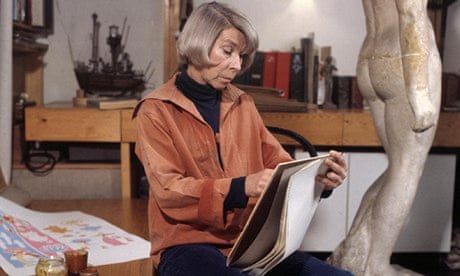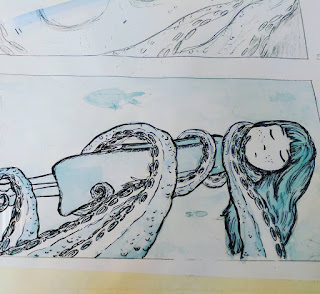I have completed my final set of three editorial illustrations! I'm not sure how much they channel POE, but they do tap into his themes and his gothic romanticism genre.
Low-Key Colours have created a dark, eerie atmosphere.
Lost the face of the moon - there was too much going on! Didn't seem as busy in the roughs but I think that's because there's a lot more information picked up in the photo (leaves, stones, cardboard) than in the drawing (the spaces where the scene exists was planned as blank space). So I ended up using a full moon without a face. I've lost a lot of the message in this image (it was originally Poe's woman in the moon visual metaphor), but I prefer it without. Sometimes simple is best.
Worried that this one didn't really suit the rest of the set. In order for the girl to be seen in print, I had to make the blues lighter than the other two prints. This has made the tone a little lighter. Is it too cute? Not spooky enough?
This is the one image that I didn't really change much after the last peer review. My peers thought it was ready and I thought the image was everything I was aiming for so I left this one be.
Much less photoshopped than the other two images - to a certain extent, I wish I'd left those alone too because they have been over-edited and fiddled with... THIS ONE IS RAW.
Came in this morning to print and Josh said my images 'belong on the set of a Tim Burton movie' which made my day!
PHYSICAL PRINTS
they would have looked a lot better if I'd had them printed professionally. A nice matte paper? Funky stock? Bronte booked in to print hers downstairs and they looked MIGHTYFINE. This brief didn't require us to invest in swish prints but it's always worth putting a little extra effort into presenation and production.
2 COLOURS
Ben commented that several prints in the room weren't actually 2 colour! This was a result of over-photoshopping and I'm not sure if mine count as two colours or more!
CRIT FEEDBACK
Effectiveness of the Concepts/Messages
Communicate tone and feeling rather than a specific message
I think I might have got a bit sidetracked by the FEELING. Similarly to Visual Narratives last year, I moved away from the message and focused on creating atmosphere. I'm happy with the atmosphere, it's very Emily Strange/Mona the Vampire - charming spook - but I am starting to wonder if I've been forgetting about the task at hand AGAIN. The only issue with PASSION is getting TOO MUCH INTO the work. I think I got lost in those spooky trees and forgot to say anything about the subject.
moody and eerie, dark and mysterious, intriguing - drawn in to the world
they feel like snippets of a scene
Visual Language and Tone of Voice
Brilliant character and storytelling
atmospheric and interesting
like a storybook - makes me want to read it
tones of blue create a dark, moody atmosphere
love the mix of 2D and 3D
3D illustration is your thing!
Magical atmosphere, great use of puppetry
3D works well for the compositions
Visual Quality:
Photos have depth, high level of craft
Amazing detail and amount of work put in
so much effort and skill in the craft of these, but LOVED your 2D illustrations! Wish you had developed them further. You're obviously so good at 3D but would have liked to see something a bit different to your normal stuff
IS THIS NORMAL? Am I sticking to ONE THING? This is the only comment that sort of got me a bit this week. It's not negative, but I can't help but take it as a bit of an 'I told you so'... I didn't listen to the advice I was given. Did I do the wrong thing?
Magical! Loads of detail. Level of craft is amazing
how did you make these in 7 days??
Really pleased that my hard work shows. I have put in a lot of effort (I made those tentacles over and over again until they were how I wanted)
Enchanting. You've used your 3D skills in a great way to compliment some 2D images - lovely depth!
Constructive feedback
OTHER WORK I LIKED:
Loads of work in the room! I'm proud of us, we've produced so much in such a short space of time.
Dana's feminine and surreal Leonora Carrington prints.
Galuh's humorous and silly collages - loads of outcomes, quickly produced. She obviously enjoyed the process of MAKING.






























